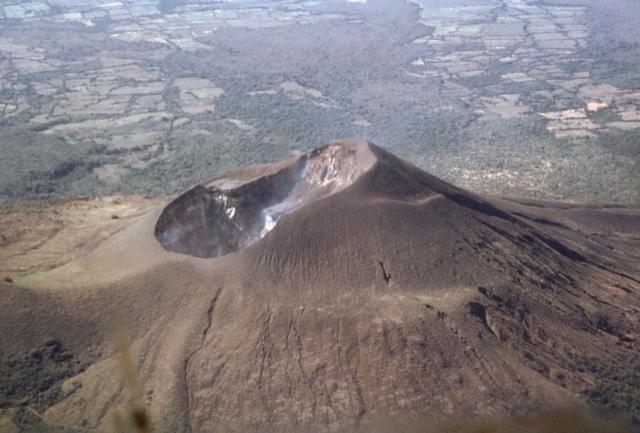New eruption of Telica volcano startles nearby villagers, Nicaragua

A new and sudden eruption occurred at 12:50 UTC on September 25, 2013, at Telica volcano, Nicaragua. A moderate ash explosion took place at the summit crater and produced an ash plume about 1 – 1.5 km high.
The National System for Disaster Prevention and Mitigation (SINAPRED) said its seismograph readings did not indicate any rising lava associated with the explosion and geologists said this probably means the blast was due to a localized buildup of pressure within the mountain’s crater.
During the past months, the volcano had experienced frequent swarms of earthquakes.
SINAPRED warned residents to protect their water and food supplies from falling volcanic debris, but activity soon subsided.
The latest entry to GVP's weekly volcano database was during the week of September 12 – 18, 2012:
During September 10 – 11 INETER reported "jet" sounds from Telica, two incandescent fumaroles, and gas-and-steam plumes rising 100 – 200 m above the crater. On September 11 two small explosions occurred in the crater. During September 12-14 and 17th gas plumes rose 30 – 150 m and incandescence from the crater was observed. Gas measurements on September 14 and 17 showed normal levels of sulfur dioxide emissions.
At the same time, three powerful blasts from the nearby San Cristobal volcano prompted authorities to evacuate about 3 000 people.
Telica, one of Nicaragua's most active volcanoes, has erupted frequently since the beginning of the Spanish era. The Telica volcano group consists of several interlocking cones and vents with a general NW alignment. Sixteenth-century eruptions were reported at symmetrical Santa Clara volcano at the SW end of the Telica group. However, its eroded and breached crater has been covered by forests throughout historical time, and these eruptions may have originated from Telica, whose upper slopes in contrast are unvegetated (GVP).
The steep-sided cone of 1061-m-high Telica is truncated by a 700-m-wide double crater; the southern crater, the source of recent eruptions, is 120 m deep. El Liston, immediately SE of Telica, has several nested craters. The fumaroles and boiling mudpots of Hervideros de San Jacinto, SE of Telica, form a prominent geothermal area frequented by tourists. Geothermal exploration has occurred nearby.
Featured image: The 700-m-wide double summit crater of Telica volcano is seen here in an aerial view from the north with farmlands of the Nicaraguan depression in the background. The 1061-m-high volcano is the highest and most recently active of the Telica volcanic complex. The Telica volcano group consists of several interlocking cones and vents with a general NW alignment. The bench at the lower right and the ridge at the left are remnants of older craters of the complex. Photo by Jaime Incer, 1991.

Commenting rules and guidelines
We value the thoughts and opinions of our readers and welcome healthy discussions on our website. In order to maintain a respectful and positive community, we ask that all commenters follow these rules:
We reserve the right to remove any comments that violate these rules. By commenting on our website, you agree to abide by these guidelines. Thank you for helping to create a positive and welcoming environment for all.